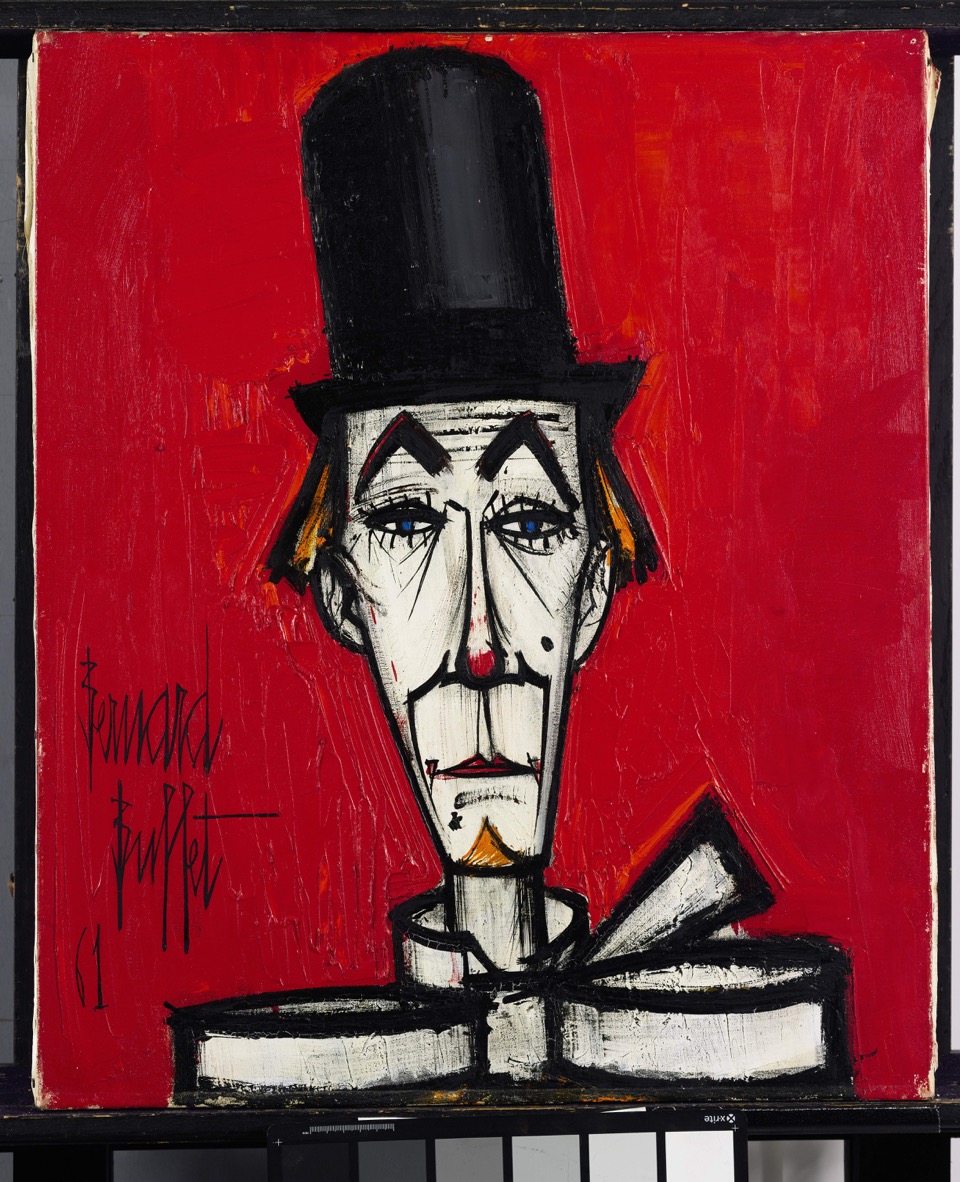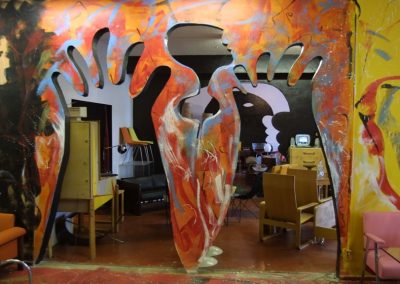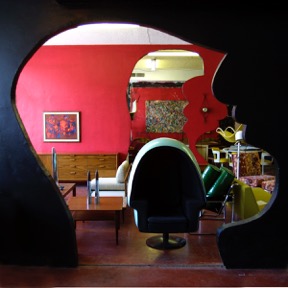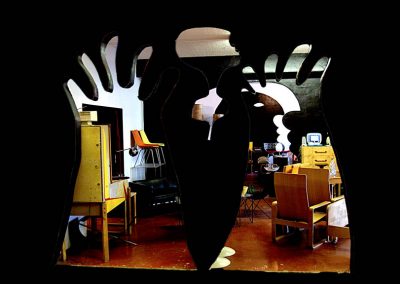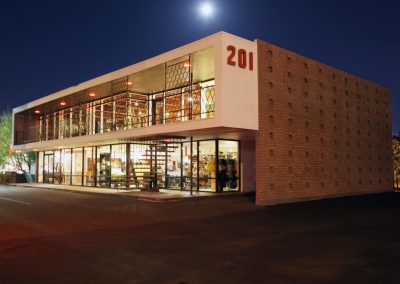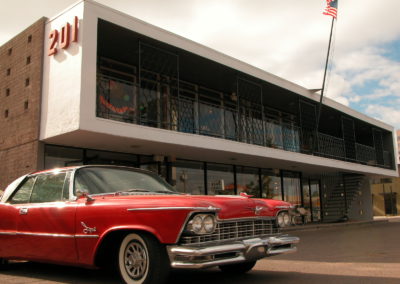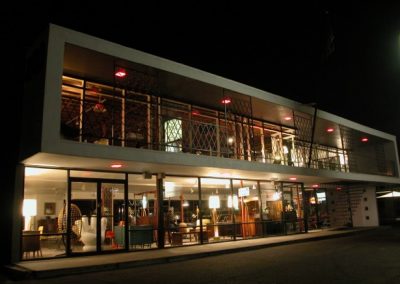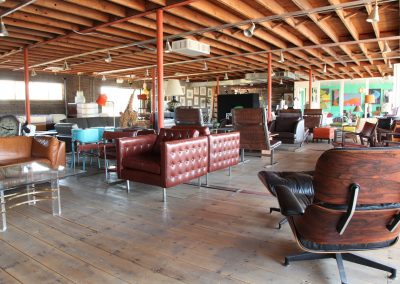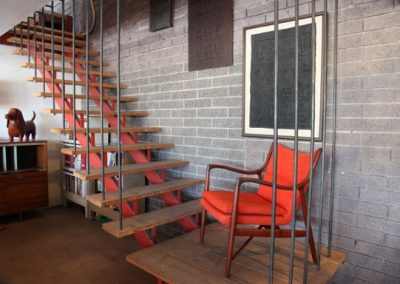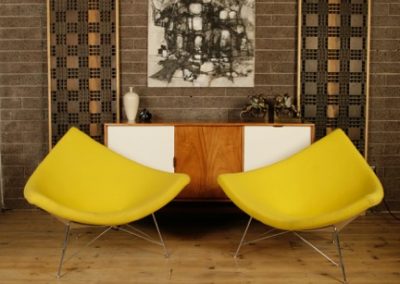In the mid-20th century, my grandparents would meet and get to know artists wherever they traveled or lived. This is a photograph of my grandfather with Siqueiros, the celebrated Mexican muralist and graphic painter. Siqueiros is seen signing a print to my grandparents. That print now hangs in my home and brings both what I do and how I see the world full circle.
My grandparents connection to the art and the artists that created them helped shape that philosophy in me. They furnished their home from their travels and finds from flea markets. Today, my wife, kids, and I live with life-size Krishna sculptures, cast paper works from China, and furniture made by Arizona masters Allen Ditson and Lee Porzio.
We find that it does not matter where an object is from but rather that its imbued with the soul and spark of its creator. We try with the works that we restore and sell at RED to be true to their creators, for they were visionaries who help us transform our environments and how we relate to them.
A piece of art, a well designed chair, both carry stories and history that transform banality into magic – blank walls into conversations with friends and ancestors.
The name RED comes from a painting that was always with my grandparents. I connected with it as a child and to this day am moved when I think of it. I hope that some of the items on our site and in our store have that same effect on you. That they spark a memory, a connection to the craftsmanship, or just simply make you smile.
– Jonathan Wayne
Owner
Our History
In Phoenix during the early 90’s, I used to teach tennis professionally and do art. Mainly paintings, prints, and ceramics. In my mid 20’s, after a stint in Carmel teaching tennis, I decided on a whim that Seattle was a place I wanted to explore. With limited funds and lofty ideas I traveled there and found a space on 1st Avenue and Wall in the same building as a homeless shelter. The soup kitchen was directly next to me and a chapel next to it. It was the perfect location for an art gallery. With the help of Kenny and George, two of the people living in the shelter at the time, we sanded the floors, built platforms in the front, and painted the walls. “Soul In The Wall” was born.
Living in the back in a 10’ x 10’ space, I showered upstairs where the recovering addicts called home, and in return for helping prepare and disperse food, was fed myself. I worked on my art in and also wrote a lot. I sold an art piece here and there – just enough to survive. It was during that year that I bought and sold my first piece of furniture.
I happened to go into an Antique store and noticed a sofa from the 1930’s in its original fabric selling for $800. Coincidently, later that day I went into a thrift store with that same sofa in a different color. I noticed that it was going to be selling for half-price the following day. I bought the sofa from the thrift store, resold it to the antique shop and turned a $100 profit. The process had begun. I didn’t know what I was doing, but it felt good. I was rescuing pieces that had been forsaken, damaged, forgotten about, and finding them new homes.
After a year in Seattle I returned to Phoenix. I would spend days at the dollar-a-pound yard hunting for old Westerns, or Vans, or Levi’s and would sell my wares to the local stores. It was also around that time that I started going to local auctions. It was there that I was introduced to larger than life characters who were kings at what they did. If anyone dared step on their toes or bid them up, hell hath no fury for that sad sort. I was the sad sort: desperate to permeate that world and stepped on many a toe to get there.
Leon was the king of appliances. He looked like a human cockroach and always wore jeans and a white Western shirt. His greasy tobacco hair was always parted to the same side and he came running whenever I was bidding on something. No matter what it was: it didn’t matter. Most of the time he didn’t even want the piece I was going for. He was initiating me. While it hurt at the time, Leon, and some of the other characters, taught me how to play the game.
The game then shifted to the Rose Bowl Flea Market in Pasadena. On the second Saturday of every month, I would load a 17’ truck by myself full of chairs, shoes, lamps, and knick-knacks. I would drive through the night and set up around four in the morning with Japanese dealers and their flashlights trying to hop on my truck as I was unloading. It was there that I met Johnny B. Wood and the Modernica brothers and Ben Stork and Andy Hackman – some of the early pioneers. If the day fared well I would stay over. If it was slow, I would drive back that night.
The leap to a store came in the late 90’s. There was a mid century shop in Phoenix called “Spine” and I had befriended Louis, the owner. We used to sit outside his store on the sidewalk and talk about Basquiat and Maurizio Cattelan, obscure music, and the overall demise of humanity. He introduced me to Paul: a master refinisher who used to refinish Steinways. (Paul is our in-house refinisher to this day). Louis was downsizing Spine and moving more into clothing than furniture. I opened up in a space at 1319 E. Mcdowell with about 1400 ft. After the first year, we procured the space next to it, then the space next to it until… the entire building was our store. Instead of doors connecting the spaces, we made cutouts of faces, hands, and hearts that you could walk through. I painted murals and posted poetry on the walls and the floors. I miss that freedom and reckless abandon a bit.
Our Location
There are a hand full of buildings in this town that always spoke to me. Gems that transcend time, stucco, and strip malls. 201 East Camelback Road made my heart beat a bit faster.
Back in June of 2006 I happened to be driving by and noticed a small “for rent” sign. I called, spoke with the owner, and met later that day to get a tour. There were fluorescent lights and layers of flooring and paint covering up the original charcoal block. There were cubicles everywhere and no interior stairs. The space was screaming to be revealed – peeled back to its original simplicity. Mike agreed to sell us the building, and though it was a stretch, we made it work.
We sand blasted the interior and exterior block, made interior stairs to match the original exterior ones, exposed the ceiling beams and sub flooring. We made the track lighting out of original 1950’s can lighting. We also made an iron fence around the back patio with the same circle motifs of the original iron work on the front. Three months later, the Smithsonian gave lectures here and we were officially open in our restored 1954 Ralph Haver building.
This is where we do what we do these days. The poetry that graced the walls and floors in our old store has been replaced by hard edge paintings, prototypes, and careful restorations, but it is still here. Permeating every stitch, every sanded surface, every choice we make.


